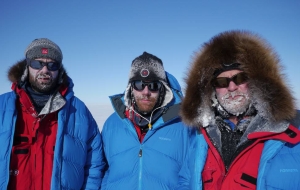The first kilometresWe set out at 9 am with the sun at our backs and the wind in our faces. At last we are moving towards our goal! Our routine will be one-hour skiing stints. Short break. Repeat over and over again. Each hour we put four kilometres behind us. Those kilometres weren’t exactly child’s play – and there are a lot of them.
“Light breeze from SSE – 34½°. To begin with, it seemed quite cold, but one gets used to anything.”– Amundsen on this day 100 years ago (Read more …) 
At our first halt, Vegard suddenly spotted a black, humanoid figure moving along a few kilometres behind us. Other people out here in the icy wasteland? “It could be an emperor penguin,” said Stein. “Yeah, maybe so,” agreed Jan-Gunnar. Our binoculars revealed that we had all been fooled. What we had seen was actually the shadow cast by a fairly large snowdrift. But we had definitely seen it moving. Fata Morgana. A mirage. An exceedingly common phenomenon near the poles. Fortunately we don’t see all the crevasses we cross, but three were of the cavernous variety that simply cannot be overlooked. The snow bridges were solid and there was no drama involved. After five stints of skiing, we called it a day. Twenty kilometres in all. A short day, but it’s important to start gradually on a trip like this one. Our bodies must become accustomed to the task. Literally step by step. So far, nobody has any aches or pains. S 79 08.154, W 164 48.130 Did you know that the sea level would rise 60 meters if all the ice in Antarctica were to melt?
But an ice-free Antarctia would never come to pass unless the entire continent were to move, and that would take millions of years. This means that the Antarctic continent’s contribution to global sea level is much less than 60 meters. But figuring out just how much less is a difficult task that the world’s scientists are currently striving to accomplish. |
South Pole 1911–2011 is an informational outreach project run by the Norwegian Polar Institute
Contact person:


